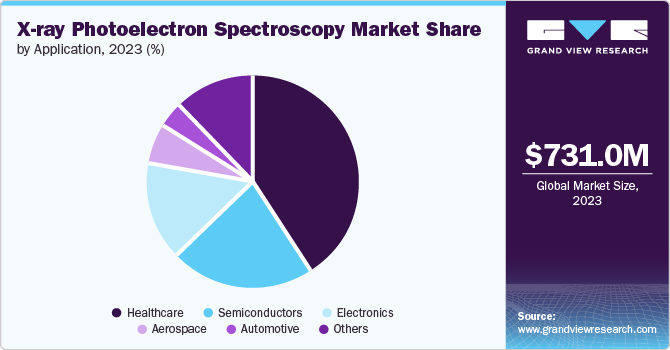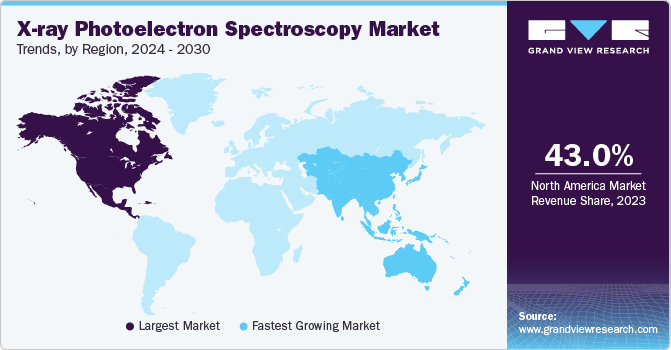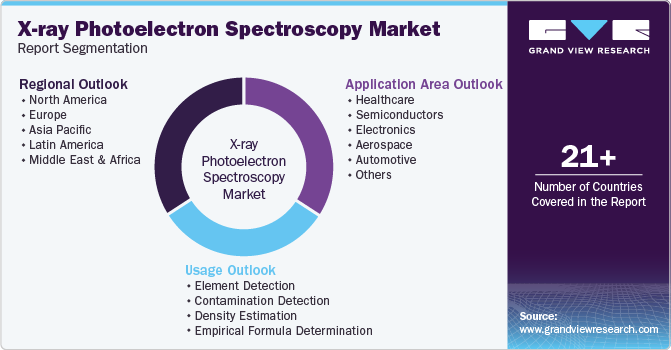
X-ray Photoelectron Spectroscopy Market Size, Share & Trends Analysis Report By Usage (By Element Detection, Contamination Detection), By Application (Healthcare), By Region, And Segment Forecasts, 2024 - 2030
- Report ID: 978-1-68038-415-4
- Number of Report Pages: 120
- Format: PDF, Horizon Databook
- Historical Range: 2018 - 2022
- Forecast Period: 2024 - 2030
- Industry: Healthcare
Market Size & Trends
The global X-ray photoelectron spectroscopy market size was valued at USD 731.0 million in 2023 and is projected to grow at a CAGR of 3.9% from 2024 to 2030. The rise in global demand for medical research, minimal medication error, technological advancements, and pure and safe drugs are some of the key drivers of the X-ray photoelectron spectroscopy (XPS) market.

The advancements in X-ray photoelectron spectroscopy technologies have improved resolution, sensitivity, and data acquisition rates. They enhance the efficiency and accuracy of material analysis, making the systems more valuable in various scientific research and industrial applications. The surge in applications of X-ray photoelectron spectroscopy has led the market to grow positively. For instance, in September 2023, research was conducted to provide advanced capabilities with upgraded optical instruments by reorganizing SPring-8’s BL09XU beamline into a beamline dedicated to hard X-ray photoelectron spectroscopy (HAXPES). This upgrade improves the microscale analysis of chemical bonding states and the performance of the HAXPES application.
Recent innovations integrating AI to analyze X-ray photoelectron spectroscopy data are expected to assist in transforming raw data into meaningful scientific knowledge. For instance, in 2023, Large Language Models (LLMs) were integrated to provide insightful guidance during the data analysis and help understand complex chemical states and material properties. Such advancements can lead to more significant data analysis processes, and the adoption rate of data analysis is likely to increase, thereby impacting the market positively in the near future.
XPS has its application in drug discovery and is used in the plasma treatment of different medical textiles, and this is anticipated to drive market growth. Plasma therapy is used to repair tissue damage caused by surgery or accident, and further processes are accomplished using modern X-ray photoelectron spectroscopy technology. This method aids in decreasing surgical site infections and improves the quality of implantation material. X-ray photoelectron spectroscopy is a powerful surface analysis technique that can detect cancer by focusing on every chemical element present and sensitive to its chemical environment. This aspect is predicted to increase the pace of acceptance of this technology shortly, thereby driving the market to grow.
In May 2023, research was conducted using XPS to study the nitrogen environment in small extracellular vesicle (EV) membranes. The focus was on the abundance of the pyridine-type bonding and the primary, secondary, and tertiary amines. This analysis showed that the nitrogen chemical environment could be related to markers of cancer disease, opening the possibility of using EVs as noninvasive blood biomarkers.
The rising government initiatives have helped create awareness regarding the level of contamination in drugs, formulations, and chemical analysis. The high-scale research and development in recent times is expected to increase the growth of the X-ray photoelectron spectroscopy market in the forecast year. For instance, the National Science Foundation (NSF) awarded a grant of USD 1.23 million to Binghamton University to acquire a Hard X-ray Photoelectron Spectroscopy (HAXPES) system. This system is expected to enable non-destructive chemical analysis of materials and provide access to advanced research facilities for researchers across the U.S.
Usage Insights & Trends
Element detection dominated the market and accounted for a share of 36.9% in 2023. X-ray photoelectron spectroscopy helps detect elemental composition and its analysis, depth profiling, chemical state identification, trace element detection, and surface analysis. For instance, ion beam ablation, mainly when implemented using a focused ion beam (FIB), offers precise control over material removal to study thin film interfaces and layers. This technique enables more accurate and localized analysis, enhancing spatial resolution. Thus, XPS is an excellent tool for comprehensive elemental analysis of material surfaces, providing information about the types of elements present, their concentrations, and their chemical states. X-ray photoelectron spectroscopy is a valuable technique for various applications, from materials science to semiconductor manufacturing. It is also used in element detection in the manufacturing industries, which detects elements such as corrosion and adhesion and enhances the quality of the product, driving the demand for XPS in the element detection segment.
Contamination detection is expected to grow at a significant rate of CAGR during the forecast period. XPS helps detect contamination by focusing on the bonding of elements on the surface of materials and their chemical composition. This technique ensures product quality and safety. The rise in demand for systems and technologies providing accurate results is further boosting the demand for X-ray photoelectron spectroscopy in the contamination detection segment. For instance, XPS can be used to remove carbon contamination from surfaces. Gentle ion bombardment from the system ion source, such as cluster ions, can effectively remove the top 2-3 nm carbon contamination.
Application Insights & Trends
Healthcare accounted for the largest market revenue share in 2023. This is attributed to the increased adoption rate of X-ray photoelectron spectroscopy in hospitals and healthcare institutes. The healthcare market applications include studying cell/bacteria/tissue analysis, proteins and peptides, antibody immobilization, and characterization of chemicals. For instance, in April 2021, research was conducted where XPS was used to characterize the chemistry of the outermost layer of the microorganisms and is an attractive technique owing to its surface sensitivity. This surface sensitivity helps analyze the microbial surface from the bulk of the microbial particle without any interference. This has caused the market to grow due to its high adoption rate in healthcare institutes and research centers worldwide. The rise in healthcare spending by individuals and advancement in technology, such as hyphenated techniques, is driving the demand for XPS in the healthcare segment.

Semiconductors are expected to grow at a significant rate of CAGR during the forecast period. XPS is an effective surface analysis method. Photonic materials, sensors, and quantum dots are applications in the semiconductor wafer processing industry of how X-ray photoelectron spectroscopy is used in the semiconductor field. The rise in such applications has impacted the market positively. For instance- XPS helps to analyze the chemical state and surface composition of semiconductor materials, such as silicon and silicon dioxide, which are crucial for understanding the behavior of interfaces and the impact of surface defects on device performance.
Regional Insights & Trends
It is attributed to the increasing application of X-ray photoelectron spectroscopy for ongoing technological advancements and the growing demand for spectroscopy in environmental industries, medical research, and drug safety processes, anticipated to fuel the growth of this market over the forecast period. Medical practitioners use X-ray photoelectron spectroscopy owing to the wide array of applications, and this has anticipated the growth of the market.
U.S. X-ray Photoelectron Spectroscopy Market Trends
The U.S. X-ray photoelectron spectroscopy market accounted for the 33.6% market share in the global X-ray photoelectron spectroscopy market in 2023. This growth can be attributed to the thriving research ecosystem in the U.S. with a strong focus on pharmaceuticals, nanotechnology, and advanced materials driving significant demand for XPS systems. The U.S. has many key players for X-ray photoelectron spectroscopy system manufacturers, such as Thermo Fisher Scientific Inc. and Bruker, which have a strong foothold in domestic and global markets. Their continuous product innovations and R&D investments have further helped the U.S. market position to grow. Thermo Scientific Nexsa Surface Analysis System is designed to integrate other analytical techniques, helping to maintain a high-throughput workflow assisted by the Thermo Scientific iXR Raman Spectrometer and Thermo Scientific MAGCIS dual-mode ion source.
The U.S. government provides funding and incentives for R&D activities, mostly in the domains of healthcare, advanced materials, and energy. This has anticipated the adoption of advanced analytical techniques such as X-ray photoelectron spectroscopy across different industries and domains.
Europe X-ray Photoelectron Spectroscopy Market Trends
Europe X-ray photoelectron spectroscopy was identified as a lucrative region in this industry. This is attributed to the increasing funding and investments in developed countries of this region. For instance- in February 2023, the Engineering and Physical Sciences Research Council (EPSRC) started a funding of USD 2,179,960 to UK-based research organizations to provide an X-ray photoelectron spectroscopy national research facility (NRF). Thus, the increasing demand for spectroscopy in environmental industries, reimbursement structure, and rising popularity of hyphenated technologies have helped the market grow at a significant rate.

Asia Pacific X-ray Photoelectron Spectroscopy Market Trends
The Asia Pacific XPS market is expected to grow at the fastest CAGR over the forecast period. It is attributed due to the increasing opportunities in technology-based research and development and various government initiatives. It has a large untapped opportunity in the emerging markets of India and China and is constantly improving healthcare infrastructure in these markets. For instance, in India, the government has been funding R&D efforts at academic institutions to develop and promote X-ray photoelectron spectroscopy technology. The I-STEM (Indian Science, Technology and Engineering Facilities Map) is a portal expected to drive the adoption and growth of XPS in India in the coming years. It is an Indian government initiative that lists several XPS facilities available at various research institutes across the country.
Key X-ray Photoelectron Spectroscopy Company Insights
Some of the key companies in the X-ray photoelectron spectroscopy include Thermo Fisher Scientific Inc. and Evan Analytical Group. These companies are growing their market revenue by launching new products, collaborations and adopting various other strategies.
-
Thermo Fisher Scientific Inc. is a U.S.-based provider of X-ray photoelectron spectroscopy instruments for surface analysis. Thermo Fisher Scientific Inc. offers several high-performance XPS systems such as the K-Alpha, Nexsa, and ESCALAB Xi+ models designed for ease of use and high throughput. These systems integrate X-ray photoelectron spectroscopy with other analytical techniques such as Raman spectroscopy. Thermo Fisher's XPS instruments are widely used in industrial to academic research labs.
-
Nova Ltd. aims at accreditations and alliances to expand its sales footprint and demand across countries, thus widening XPS market. Nova Ltd is focused on innovative product launches to gain higher market revenue.
Key X-ray Photoelectron Spectroscopy Companies:
The following are the leading companies in the X-ray photoelectron spectroscopy market. These companies collectively hold the largest market share and dictate industry trends.
- Thermo Fisher Scientific Inc.
- Evan Analytical Group
- Intertek Group plc
- Yokogawa India Ltd.
- Nova Ltd
Recent Developments
-
In May 2024, Kratos Analytical Ltd announced the enhancement of Cryo-XPS for AXIS Supra+, which is expected to facilitate in-situ cryo-XPS experiments at temperatures below -150°C. Cryo-XPS allows the analysis of hydrated samples, biological samples, mineral suspensions, or bacteria.
-
In May 2021, Thermo Fisher Scientific Inc. announced the fully automated Thermo Scientific Nexsa G2 surface analysis system helping to increase productivity and innovation for academic and industrial labs. It delivers significant hardware and software improvements, enabling researchers to uncover surface chemistry insights.
X-ray Photoelectron Spectroscopy Market Report Scope
|
Report Attribute |
Details |
|
Market size value in 2024 |
USD 752.2 million |
|
Revenue forecast in 2030 |
USD 948.9 million |
|
Growth Rate |
CAGR of 3.9% from 2024 to 2030 |
|
Base year for estimation |
2023 |
|
Historical data |
2018 - 2022 |
|
Forecast period |
2024 - 2030 |
|
Quantitative units |
Revenue in USD billion and CAGR from 2024 to 2030 |
|
Report coverage |
Revenue forecast, company ranking, competitive landscape, growth factors, and trends |
|
Segments covered |
Usage, application, region |
|
Regional scope |
North America, Europe, Asia Pacific, Latin America, MEA |
|
Country scope |
U.S., Canada, Mexico, UK, Germany, France, Italy, Spain, Denmark, Sweden, Norway, Japan, China, India, Australia, South Korea, Thailand, Brazil, Argentina, KSA, UAE, South Africa, Kuwait |
|
Key companies profiled |
Thermo Fisher Scientific Inc, Evan Analytical Group, Intertek Group plc, Yokogawa India Ltd, Nova Ltd. |
|
Customization scope |
Free report customization (equivalent up to 8 analysts working days) with purchase. Addition or alteration to country, regional & segment scope. |
|
Pricing and purchase options |
Avail customized purchase options to meet your exact research needs. Explore purchase options |
Global X-ray Photoelectron Spectroscopy Market Report Segmentation
This report forecasts revenue growth at global, regional, and country levels and provides an analysis of the latest industry trends in each of the sub-segments from 2018 to 2030. For this study, Grand View Research has segmented the X-ray photoelectron spectroscopy market report based on usage, application, and region.

-
Usage Outlook (Revenue, USD Million; 2018 - 2030)
-
Element Detection
-
Contamination Detection
-
Density Estimation
-
Empirical formula Determination
-
-
Application Area Outlook (Revenue, USD Million; 2018 - 2030)
-
Healthcare
-
Printing
-
Packaging
-
Others
-
-
Semiconductors
-
Electronics
-
Aerospace
-
Automotive
-
Others
-
-
Regional Outlook (Revenue, USD Million; 2018 - 2030)
-
North America
-
U.S.
-
Canada
-
Mexico
-
-
Europe
-
UK
-
Germany
-
France
-
Italy
-
Spain
-
Denmark
-
Sweden
-
Norway
-
-
APAC
-
Japan
-
China
-
India
-
Australia
-
South Korea
-
Thailand
-
-
Latin America
-
Brazil
-
Argentina
-
-
MEA
-
South Africa
-
Saudi Arabia
-
UAE
-
Kuwait
-
-
We are committed towards customer satisfaction, and quality service.
"The quality of research they have done for us has been excellent."




